A spirometer is a medical device used to evaluate the functioning of the lungs. It measures the amount of air you inhale and exhale. These measurements will be compared with a normal result for someone of your age, height and sex, which will help show if your lungs aren’t working properly.
In this buyer’s guide we will discuss the:
- Types of spirometer
- EVERYTHING YOU NEED TO KNOW ABOUT INCENTIVE SPIROMETER:
- Volume- oriented incentive spirometry
- Flow-oriented incentive spirometry
- 5 Best spirometer models in India 2021: Detailed
- Things to consider before buying spirometer:
- Best spirometer brands in India
- Spirometer Price Range List
- Frequently asked questions (FAQs)
Types of spirometer
A. Whole body plethysmograph
Body plethysmography is a pulmonary (lung-related) function test that determines how much air is in your lungs after you take in a deep breath. It also measures the amount of air left in your lungs after you exhale as much as you can. This test gives healthcare providers information about how well your lungs are functioning and helps guide them in your plan of care.
B. Pneumotachometer
This spirometer measures the flow rate of gases by detecting pressure differences across fine mesh. One advantage of this spirometer is that the subject can breathe fresh air during the experiment.
C. Fully electronic spirometer
Electronic spirometers have been developed that compute airflow rates in a channel without the need for fine meshes or moving parts. They operate by measuring the speed of the airflow with techniques such as ultrasonic transducers, or by measuring pressure difference in the channel. These spirometers have greater accuracy by eliminating the momentum and resistance errors associated with moving parts such as windmills or flow valves for flow measurement. They also allow improved hygiene by allowing fully disposable air flow channels.
D. Incentive spirometer
This spirometer is specially designed to encourage improvement of one’s lung function.
E. Peak flow meter
This device is useful for measuring how well a person’s lungs expel air.
F. Windmill-type spirometer
This type of spirometer is used especially for measuring forced vital capacity without using water; it has broad measurements ranging from 1000 ml to 7000 ml. It is more portable and lighter than traditional water-tank type spirometers. This spirometer should be held horizontally while taking measurements because of the presence of a rotating disc.
EVERYTHING YOU NEED TO KNOW ABOUT INCENTIVE SPIROMETER:
An incentive spirometer is a medical device that facilitate visual cues to the patients that the desired flow or volume has been achieved. The basis of incentive spirometry involves having the patient take a sustained, maximal inspiration (SMI). An SMI is a slow, deep inspiration from the Functional Residual Capacity up to the total lung capacity, followed by ≥5 seconds breathe hold.
Two types of incentive spirometry are commercially available:
- Volume- oriented incentive spirometry (VIS)
- Flow-oriented incentive spirometry (FIS)
Volume- oriented incentive spirometry
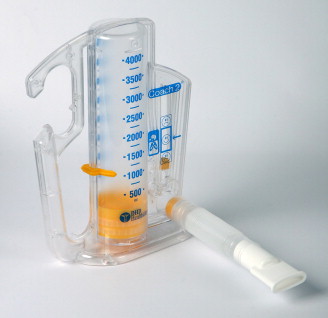
The volume-incentive spirometer (also known as Coach 2 device) enables the patient to inhale air through a mouthpiece and corrugated tubing which is attached to a plastic bellows. The volume of air displaced is indicated on a scale located on the device enclosure. After the patient has achieved the maximum volume, the individual is instructed to hold this volume constant for 3 to 5 seconds. Numbers on the device show how deeply you breathe in. The volumetric incentive spirometer is better in case of cardiac and thoracic surgeries because it provides the appropriate feedback for a slow sustained inspiration and volume.
Flow-oriented incentive spirometry

The flow-oriented incentive spirometer (Tri flow device) consists of three chambers in series, each of which contains a ball. When the patient’s effort generates a sub atmosphere pressure above the ball, it rises in the chamber. An inspiratory flow of 600 mL/s is required to raise the first ball, an inspiratory flow of 900 mL/s is required to elevate the first and second balls, and a flow of 1200 mL/s is required to elevate all three balls. The volume-oriented incentive spirometer is a compact device of 4000 mL capacity and has a one-way valve to prevent exhalation into the unit. A sliding pointer indicates the prescribed inspiratory volume and an inspiratory flow guide coaches the subject to inhale slowly.
FACT: Earlier studies shows that Flow-oriented devices (Tri flow device) enforce more work of breathing and increase muscular activity of the upper chest. Volume-oriented devices (Coach 2 device) enforce less work of breathing and improve diaphragmatic activity.
5 Best spirometer models in India 2021: Detailed

Clarity SpiroTech spirometer
- Product description:
- Brand: Clarity Medical
- Model: Spiro Tech
- Product Features:
- Compact & portable hardware.
- Graphical & tabular pre/post-test comparison.
- Predicted equation builder is provided to add/edit and evaluate the equation.
- Facility to search for patient by name, ID, reference number and referring doctor.
- Facility to take up to 10 tests of a particular patient.
- Facility to print data in different formats as per user’s requirements.
- Facility to generate PDF files or print formats and can be sent through email as well.
- Facility to observe FVC trends on the main screen with result values.
Product Specifications:
Type: Hand-Held Spirometer
Power supply: Powered by USB
Interface port: USB
Screen resolution: 1024 x 768 and above
Air flow range (L/sec): 10 L/sec to 16L/sec
Max volume range: 8 liter
Flow detection: Volume Differential
Temperature: 0 to 45 C
The SpiroTech is Clarity Medical’s portable spirometer variant. It is designed to be operated in conjunction with a laptop computer, and derives its operating power entirely through a USB port.
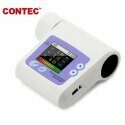
Contec Portable Spirometer SP10
- Product description:
- Brand: Contec
- Model: SP-10 Handheld spirometer
- Product Features:
- Ultra-thin design for portable carrying, easy operation for convenient test.
- Large TFT screen to display the test result clearly. Measure FVC, PEF, FEV1, etc. parameters synchronously.
- Support diagnosis evidence by volume and flow rate chart display.
- With precise, credible test result and good consistency.
- Built-in predicted value, display the test current condition by red, yellow, and green bar.
- Provide repeated measure and memorize the correlative data. Communication with the computer with the USB (or Bluetooth), which can calculate data, analyze trend and export.
- Built-in lithium battery, Battery power display. Automatic power-off when there is no operation in one minute.
Product Specifications:
Type: Hand-Held Spirometer
Power supply: DC3.7V Rechargeable Lithium Battery
Interface port: USB
Software support: Yes
Air flow range (L/sec): 1L/sec to 16L/sec
Dimensions: 97 x 89 x 36 Mm
Weight: 150 G
A digital spirometer is an apparatus used in the spirometry test for measuring the volume of air inspired and expired by the lungs. It is used in hospitals and clinics and helps in measuring the capacity of the lungs to inhale in and exhale out air. Before you do the test, a nurse, a technician or your doctor will give you specific instructions.
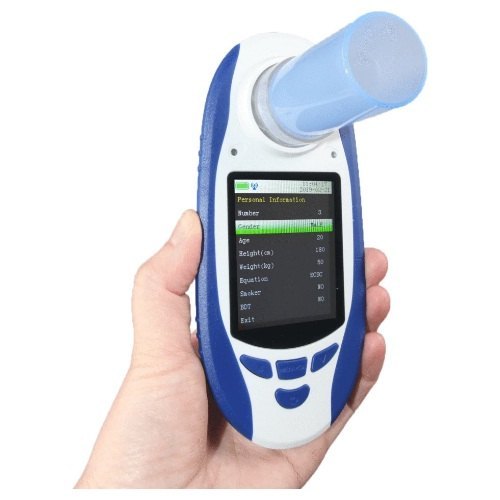
CONTEC SP10BT Digital Spirometer Lung Breathing Diagnostic Spirometry
- Product description:
- Brand: Contec
- Model: SP-10BT Digital spirometer
- Product Features:
- Forced Vital Capacity (FVC), Forced Expired Volume in one second (FEV1), the ratio of FEV1 and FVC (FEV1/FVC), Peak expiratory flow (PEF), 25% flow of the FVC (FEF25), 50% flow of the FVC (FEF50), 75% flow of the FVC (FEF75) and average flow between 25% and 75% of the FVC (FEF2575) can be measured.
- Besides, the test condition can be shown by the ratio of the measured value and the predicted value.
- Flow rate-volume chart, volume-time chart display.
- Data memory, delete, upload and review.
- Trend chart display.
- Calibration.
- Information prompts when volume or flow goes beyond the limits.
- Automatic power off when there is no operation in two minutes.
- Rechargeable lithium battery and with charging tips.
- Battery power display.
Product Specifications:
Type: Digital Spirometer
Power supply: DC3.7V Rechargeable Lithium Battery
Display Mode: 2.8” color TFT-LCD
Display Resolution: 240*320
Volume Range: 0- 10L
Air flow range (L/sec): 0L/sec to 16L/sec
Working current: 200 mA
Dimensions: 165 mm (L) × 75 mm (W) ×30 mm (H)
Weight: 150 G
Spirometer is a hand-held equipment for checking lung conditions, adopts the infrared mode for measuring relative items, it is applicable for hospital, clinic, and family for routine test.
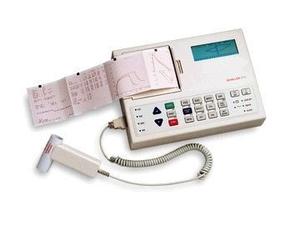
Schiller Spirometer Machine SP1
- Product description:
- Brand: Schiller
- Model: Spirovit SP1
- Product features:
- Portable Light Weight 2.9kg Spirometer with LCD display
- Real time Flow Volume Loops and detail measurements matrices.
- System’s Inbuilt High Resolution Printer provides easy to read reports within seconds.
- Automatic Interpretation
- Operable by Mains and Battery with inbuilt Charger
- 5hours Battery back up
- Display for FVC, SVC, MVV, MV
- Pneumatochromate Flow Sensor
- Internal memory for up to 100 tests
- Built-in mains and battery operation
Product Specifications:
Type: Desktop Spirometer
Power consumption: Max. 28 VA
Display Mode: 2.8” color TFT-LCD
Printer: Yes
Volume Range: 0- 15L
Air flow range (L/sec): 0L/sec to 16L/sec
Chart paper: Thermo reactive, Z-Folded, Width 90 Mm/3.6 In, Perforation Each Page
Dimensions: 290 × 210 × 69 mm
Weight: 6.3 lbs.
Battery capacity: 6 Hours of normal use
The SPIROVIT SP1 is a unique solution to simplify complex lung function testing. The LCD displays real-time flow/volume loops and detailed measurement matrices. The data can be either printed within seconds or transmitted to a PC.
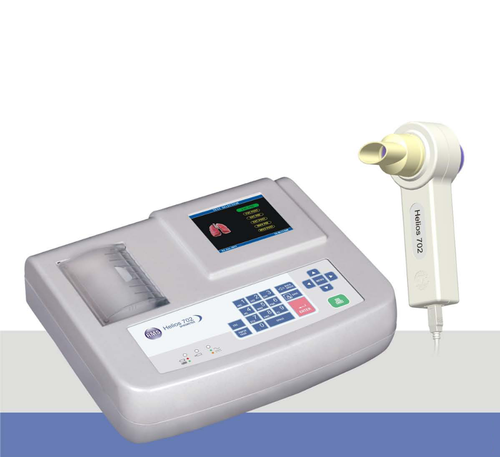
HELIOS 702 Portable Spirometer
- Product description:
- Brand: RMS
- Model: RMS Helios 702
- Product Features:
- High resolution color graphic TFT
- Built-in thermal printer
- Storage for 2500 patient data
- FVC, SVC and MVV test
- Evaluation of 51 vital parameters with interpretation
- Indian predicted equations
- Mains and Battery operations
- Facility to download data to PC
Product Specifications:
Type: Desktop Spirometer
Frequency: 50 Hz
Display Mode: 3.5” color TFT-LCD
Printer: Yes
Air flow range (L/sec): 10L/sec to 16L/sec
Graphics display: 320 x 240 Pixels
Dimensions: 288 × 238 × 85 mm
Weight: 1.8 kg
Battery type: 1.2 AH
Max volume: 8 liters
RMS Helios Series of Spirometers are available in PC Based and Standalone Versions capable of diagnosing, differentiating and measuring various pulmonary diseases. The Helios series comes with a highly advanced and user-friendly Software offering 34 Parameter readings, Pre-Post Bronchodilation Results, Percentage Improvement and Lung Age Calculations.
Things to consider before buying spirometer:
- Don’t buy the cheapest spirometer you can find. Remember, this is an investment. The adage “you get what you pay for” definitely applies to spirometers.
- Ideally, try a spirometer before you purchase. It is best to try several to get a sense of the features. Many manufactures will have reps available to do onsite demonstrations.
- Pick a spirometer with a simple and functional user-interface.
- Some spirometers no longer require daily calibration and can hold the factory calibration for multiple years. This avoids the need to perform a daily calibration check on the device. This can be an important time-saver.
- Only buy a spirometer from an established manufacturer.
- Buy a spirometer that uses a disposable sensor.
- Don’t buy a digital peak flow meter (PFM) thinking you can use it in place of a spirometer.
Best spirometer brands in India
- Clarity medical
- Schiller
- RMS
- Contec
Spirometer Price Range List
| S.NO | MODEL NAME | PRICE |
| 1. | SpiroTech | 18,000-22,000 |
| 2. | Contec SP-10 Handheld spirometer | 24,000-27,000 |
| 3. | Contec SP10BT | 24,000-25,000 |
| 4. | Spirovit SP1 | 75,000- 136,500 |
| 5. | RMS Helios 702 | 72,000-90,000 |
Conclusion:
Spirometry testing is simple. You should be able to turn on your spirometer, run your test, and get on with your day. You and your staff are extremely busy. Avoid cheap, inefficient spirometers that will ruin your confidence and productivity. The Jones Satellite/Base Station provides the fastest test speed, the fastest print speed, and the lowest cost per test. That’s why more healthcare providers rely on the Jones Satellite/Base Station than any other spirometer.
Frequently asked questions (FAQs)
Q1. What is spirometer and what is it used for?
A spirometer is a diagnostic device that measures the amount of air you’re able to breathe in and out and the time it takes you to exhale completely after you take a deep breath. A spirometry test requires you to breathe into a tube attached to a machine called a spirometer.
Q2. Is spirometer exercise good for lungs?
A spirometer is a diagnostic device that measures the amount of air you’re able to breathe in and out and the time it takes you to exhale completely after you take a deep breath. A spirometry test requires you to breathe into a tube attached to a machine called a spirometer.
Q3. How many times a day should you use a spirometer?
Take 10 to 15 breaths with your spirometer every 1 to 2 hours, or as often as instructed by your nurse or doctor.
Q4. What is the goal of incentive spirometry?
The purpose of incentive spirometry is to facilitate a sustained slow deep breath. Incentive spirometry is designed to mimic natural sighing by encouraging patients to take slow, deep breaths.
Q5. Will a spirometer help with COPD?
Spirometry can detect COPD even in its earliest stage, even before any obvious symptoms are noticeable. Along with diagnosing COPD, this test can also help track progression of the disease, assist in staging, and even help to determine treatments that might be most effective.


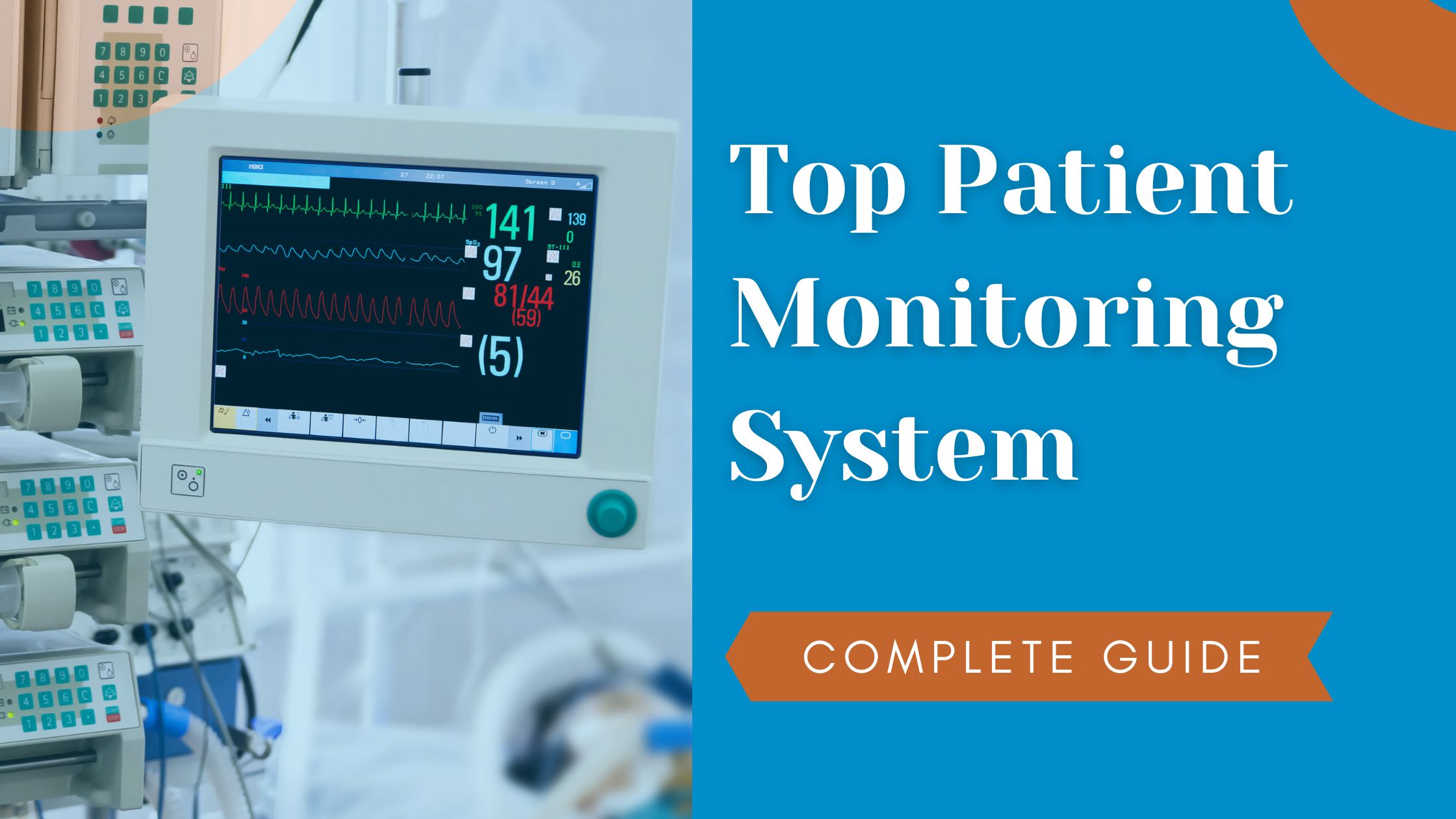
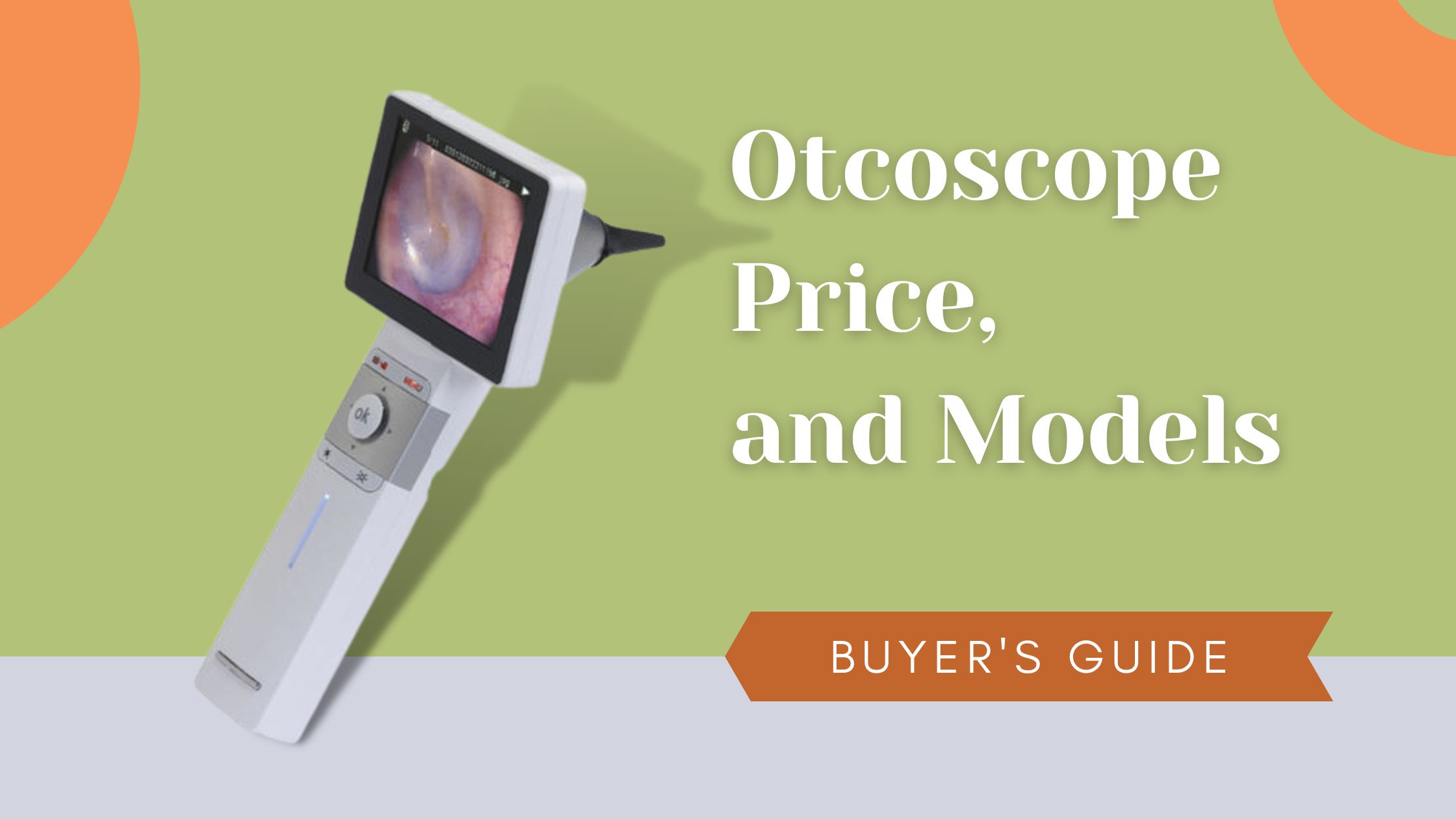
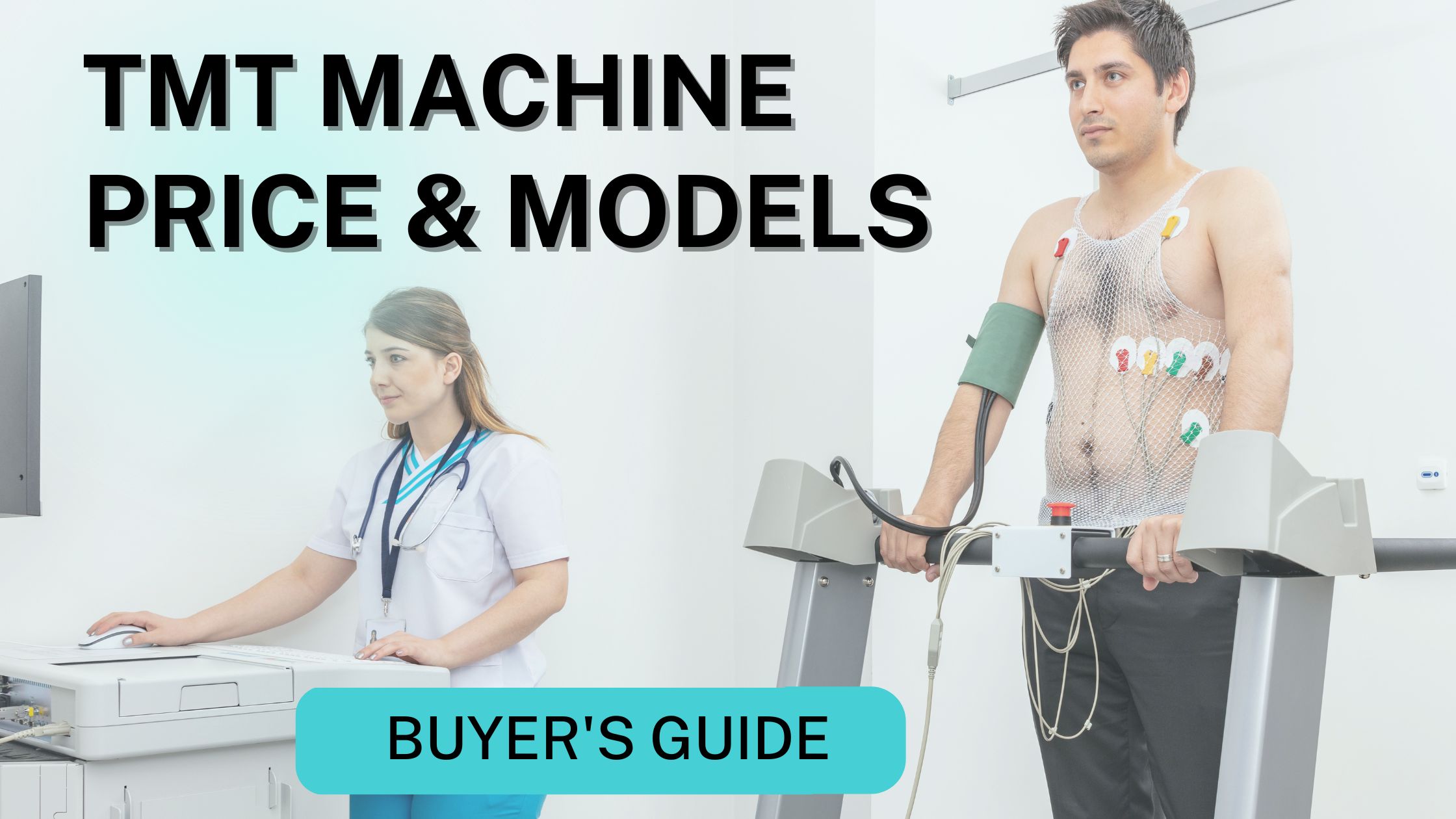
Really informative.
Very helpful content.